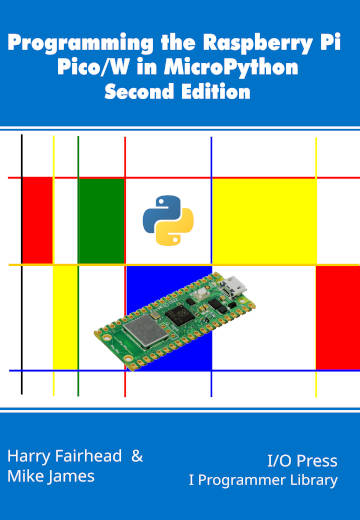Page 3 of 3
Complete Listing
import rp2
from machine import Pin
@rp2.asm_pio(set_init=(rp2.PIO.OUT_LOW,rp2.PIO.OUT_LOW),
autopush=True, in_shiftdir=rp2.PIO.SHIFT_LEFT)
def dht22():
wrap_target()
label("again")
pull(block)
set(pins, 0)
mov(x, osr)
label("loop1")
jmp(x_dec, "loop1")
set(pindirs, 0)
wait(1, pin, 0)
wait(0, pin, 0)
wait(1, pin, 0)
wait(0, pin, 0)
set(y, 31)
label("bits")
wait(1, pin, 0) [25]
in_(pins, 1)
wait(0, pin, 0)
jmp(y_dec, "bits")
set(y, 7)
label("check")
wait(1, pin, 0)[25]
set(pins,2)
set(pins,0)
in_(pins, 1)
wait(0, pin, 0)
jmp(y_dec, "check")
push(block)
wrap()
class DHT22():
def __init__(self, gpio):
self.sm = rp2.StateMachine(0, dht22, freq=490196,
Summary
The DHT22 is a low-cost temperature and humidity sensor.
It uses a custom single wire bus which is not compatible with the 1-Wire bus.
Its asynchronous protocol is easy to implement directly in user space.
A very simple checksum is used to detect errors.
It is possible to implement the protocol as defined in the datasheet using a PIO by using counting loops to time each pulse.
A better use of the PIO is to notice that the protocol can be decoded by testing the state of the line a fixed time after the rising edge.
Programming the Raspberry Pi Pico/W In MicroPython Second Edition
By Harry Fairhead & Mike James
Buy from Amazon .
Contents
Preface
Chapter 1 The Raspberry Pi Pico – Before We Begin
Chapter 2 Getting Started
Chapter 3 Getting Started With The GPIO
Chapter 4 Simple Output
Chapter 5 Some Electronics
Chapter 6 Simple InputSimple Input
Chapter 7 Advanced Input – Events and Interrupts
Chapter 8 Pulse Width ModulationPWM
Chapter 9 Controlling Motors And ServosDC Motors
Chapter 10 Getting Started With The SPI Bus
Chapter 11 A-To-D and The SPI Bus
Chapter 12 Using The I2C Bus
Chapter 13 Using The PIO
Chapter 14 The DHT22 Sensor Implementing A Custom ProtocolA PIO Driver For The DHT22
Chapter 15 The 1‑Wire Bus And The DS1820
Chapter 16 The Serial Port
Chapter 17 Using The Pico W - WiFiHTTP Client Sockets ***NEW!
Chapter 18 Asyncio And Servers
Chapter 19 Direct To The HardwareDirect To The Hardware
Also of interest:
Raspberry Pico File System
To be informed about new articles on I Programmer, sign up for our weekly newsletter , subscribe to the RSS feed and follow us on Twitter, Facebook or Linkedin .
Google Releases Python Client For Data Commons 01/07/2025
Google has released a new Python client library for Data Commons based on the V2 REST API. They say the new library enhances how data developers can make use of Data Commons.
Windows 11 Overtakes Windows 10 - But Not In Europe 08/07/2025
With the end of support of Windows 10 just three months away, Windows 11 has finally edged ahead of Windows 10 in terms of Desktop Windows Version Market Share on a Worldwide Basis. In Europe, h [ ... ]
More News
Comments
Make a Comment or View Existing Comments Using Disqus
or email your comment to: comments@i-programmer.info



